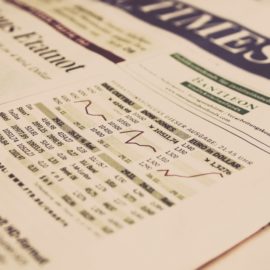

This article is an excerpt from the Shortform book guide to "The Most Important Thing" by The Princeton Language Institute and Abby Marks Beale. Shortform has the world's best summaries and analyses of books you should be reading.
Like this article? Sign up for a free trial here.
What is a market cycle? What determines intrinsic value?
According to The Most Important Thing by Howard Marks, one reason why securities’ prices can diverge from their intrinsic value is that investing markets undergo cycles. These are pricing fluctuations often driven by factors beyond the business fundamentals that determine intrinsic value.
Below we’ll examine the origins of market cycles, their implications, and how investors can exploit them for their own gain.
Investing Cycles and Their Origins
What is a market cycle and how does it work? Marks explains that securities’ markets are cyclical—they oscillate between highs and lows in the wake of psychological changes among investors. In light of these cycles, Marks argues that investors should avoid extrapolating from recent trends because these trends are often upended when cycles shift.
To understand Marks’s argument, it helps to first understand the origins of market cycles. According to Marks, cycles occur as investors alternate between excessive risk tolerance and excessive risk aversion. Excessive risk tolerance generates cyclical highs as investors become too optimistic and overpay for securities under the assumption that prices can only increase. Excessive risk aversion yields cyclical lows as investors grow pessimistic and invest too sparingly.
Because investors’ attitudes toward risk fluctuate rather than remain static, Marks concludes that it’s a mistake to assume the future will look like the recent past when investing. For example, novice investors might invest in the stock market after it grew exponentially in the last year, assuming it will do so again in the next year, but according to Marks, this is a mistake: As investors become more or less risk averse, securities’ markets that can experience wide swings on a yearly basis.
| What Factors Drive Market Cycles? Although Marks argues that securities markets undergo cycles, he doesn’t offer an in-depth account of the factors that drive the changes in these cycles. But, in Irrational Exuberance, Robert Shiller attempts to do just that. Shiller argues that the trends in investing cycles result from three kinds of interconnected factors: structural, cultural, and psychological. First, he maintains that structural factors—factors that are external to markets and occur in society at large—help set the stage for investing booms. For example, he points out that the late 90s saw the rise of the internet, which increased investors’ enthusiasm and led to inflated stock prices. Moreover, as 401ks became common in the late 1900s, more investors became familiar with stocks, which increased trading. Next, he argues that cultural factors can drive investing trends by amplifying the attention investors pay to them and by creating feedback loops. According to Shiller, one such factor in the US is widespread media interest in reporting on investing news. This media involvement, he contends, creates a cascading effect when news outlets report on initial price movements, thus reinforcing them. For example, if the media reported that stocks in the tech sector had dropped, this could spur investors to sell even more of these stocks, causing further drops. Finally, Shiller writes that salient psychological anchors can impact market cycles, either by causing them to reverse course or by causing them to continue in the same direction. For example, one such anchor could be a pervasive narrative that (say) the housing market can only increase in value. This narrative could suffice to perpetuate a housing bull market, as investors will be less likely to cash in and sell their investments and more likely to hold. According to Shiller, because these narratives hold such psychological sway, they can impact the duration of investing trends. |
Exploit Investing Cycles to Increase Returns
Though cycles can ensnare novice investors looking to turn a quick profit, they can also provide lucrative opportunities for savvy investors. To that end, Marks argues that investors can generate outsized returns by taking contrarian positions at cyclical extremes because securities are significantly mispriced at these extremes.
At a broad level, Marks notes that at any given point in a cycle, most investors’ views about the market will reflect that phase of the cycle. For example, in a bull market, most investors will be optimistic, leading them to frequently buy assets and drive up prices—otherwise, there wouldn’t be a bull market to begin with. However, Marks points out that acting in line with the consensus can only lead to market-average returns, by definition. After all, if you invest the same as the majority of investors, you won’t be able to outperform them.
Consequently, Marks concludes that acting contrary to the majority of investors is necessary for above-market returns. Specifically, he contends that contrarian investing is most powerful when cycles reach extremes—for instance, purchasing securities at the peak of a bear market (when prices are about to rise) or selling securities at the peak of a bull market ( when securities are about to drop). Nonetheless, he admits that contrarian investing isn’t always advisable—after all, for large portions of investing cycles, there aren’t widespread discrepancies between price and value. So, Marks recommends that investors base contrarian decisions on rigorous analyses of intrinsic value to maximize their chance of finding market errors.

———End of Preview———
Like what you just read? Read the rest of the world's best book summary and analysis of The Princeton Language Institute and Abby Marks Beale's "The Most Important Thing" at Shortform.
Here's what you'll find in our full The Most Important Thing summary:
- Why the best approach to investing is value investing
- The common mistakes that expose investors to risks
- How market cycles work and how to use them to find mispriced securities






